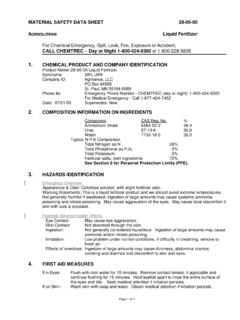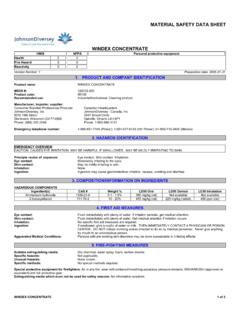Transcription of MATERIAL SAFETY DATA SHEET Propane - MKAP
1 MATERIAL SAFETY data SHEET Propane MSDS No. 6182 Revision Date: 10/16/2007 Page 1 of 7 NFPA 704 (Section 16) EMERGENCY OVERVIEW DANGER! EXTREMELY FLAMMABLE GAS - MAY CAUSE FLASH FIRE OR EXPLOSION! - COMPRESSED GAS High concentrations may exclude oxygen and cause dizziness and suffocation. Contact with liquid or cold vapor may cause frostbite or freeze burn. 1. CHEMICAL PRODUCT and COMPANY INFORMATION ) Hess Corporation 1 Hess Plaza Woodbridge, NJ 07095-0961 EMERGENCY TELEPHONE NUMBER (24 hrs): CHEMTREC (800)424-9300 COMPANY CONTACT (business hours): Corporate SAFETY (732)750-6000 MSDS (Environment, Health, SAFETY ) Internet Website SYNONYMS: Dimethylmethane; Liquefied Petroleum Gas (LPG); Sales Propane See Section 16 for abbreviations and acronyms.
2 2. COMPOSITION and INFORMATION ON INGREDIENTS * INGREDIENT NAME (CAS No.) CONCENTRATION PERCENT BY WEIGHT Propane (74-98-6) 70 min. Propylene (115-07-1) 30 max. Ethane (74-84-0) < 2 Mixed hydrocarbons [butane (C4) and higher] < Light gases from distilled and catalytically-cracked petroleum oil consisting of hydrocarbons having carbon numbers in the range of C3 through C4, predominantly Propane and propylene. This MSDS describes Propane , C3H8; other constituents exhibit similar hazards - significant differences are noted as appropriate.
3 Odorized with trace amounts of odorant (typically well below ethyl mercaptan). 3. HAZARDS IDENTIFICATION EYES Vapors are not irritating. However, contact with liquid or cold vapor may cause frostbite, freeze burns, and permanent eye damage SKIN Vapors are not irritating. Direct contact to skin or mucous membranes with liquefied product or cold vapor may cause freeze burns and frostbite. Ingestion is unlikely. Contact to mucous membranes with liquefied product may cause frostbite and freeze burns.
4 Signs of frostbite include a change in the color of the skin to gray or white, possibly followed by blistering. Skin may become inflamed and painful. INGESTION Ingestion is unlikely. Contact with mucous membranes with liquefied product may cause frostbite and freeze burns. MATERIAL SAFETY data SHEET Propane MSDS No. 6182 Revision Date: 10/16/2007 Page 2 of 7 INHALATION This product is considered to be non-toxic by inhalation.
5 Inhalation of high concentrations may cause central nervous system depression such as dizziness, drowsiness, headache, and similar narcotic symptoms, but no long-term effects. Numbness, a "chilly" feeling, and vomiting have been reported from accidental exposures to high concentrations. This product is a simple asphyxiant. In high concentrations it will displace oxygen from the breathing atmosphere, particularly in confined spaces. Signs of asphyxiation will be noticed when oxygen is reduced to below 16%, and may occur in several stages.
6 Symptoms may include rapid breathing and pulse rate, headache, dizziness, visual disturbances, mental confusion, incoordination, mood changes, muscular weakness, tremors, cyanosis, narcosis and numbness of the extremities. Unconsciousness leading to central nervous system injury and possibly death will occur when the atmospheric oxygen concentration is reduced to about 6% to 8% or less. WARNING: The burning of any hydrocarbon as a fuel in an area without adequate ventilation may result in hazardous levels of combustion products, including carbon monoxide, and inadequate oxygen levels, which may cause unconsciousness, suffocation, and death.
7 CHRONIC and CARCINOGENICITY None expected - see Section 11. MEDICAL CONDITIONS AGGRAVATED BY EXPOSURE Individuals with pre-existing conditions of the heart, lungs, and blood may have increased susceptibility to symptoms of asphxia (lack of oxygen). 4. FIRST AID MEASURES EYES In case of contact with eyes, immediately flush with clean, low-pressure water for at least 15 min. Hold eyelids open to ensure adequate flushing. Seek medical attention. SKIN Remove contaminated clothing. Wash contaminated areas thoroughly with soap and water or waterless hand cleanser.
8 Obtain medical attention if irritation or redness develops. INGESTION Risk of ingestion is extremely low. However, in cases of ingestion or oral exposure, seek immediate medical attention. INHALATION Remove person to fresh air. If person is not breathing, provide artificial respiration. If necessary, provide additional oxygen once breathing is restored if trained to do so. Seek medical attention immediately. 5. FIRE FIGHTING MEASURES FLAMMABLE PROPERTIES: FLASH POINT: -156 oF (-104 oC) AUTOIGNITION POINT: 842 oF (450 oC) OSHA/NFPA FLAMMABILITY CLASS: FLAMMABLE GAS LOWER EXPLOSIVE LIMIT (%): UPPER EXPLOSIVE LIMIT (%): FIRE AND EXPLOSION HAZARDS Liquid releases flammable vapors at well below ambient temperatures and readily forms a flammable mixture with air.
9 Dangerous fire and explosion hazard when exposed to heat, sparks or flame. Vapors MATERIAL SAFETY data SHEET Propane MSDS No. 6182 Revision Date: 10/16/2007 Page 3 of 7 are heavier than air and may travel long distances to a point of ignition and flash back. Container may explode in heat or fire. Runoff to sewer may cause fire or explosion hazard. EXTINGUISHING MEDIA Dry chemical, carbon dioxide, Halon or water.
10 However, fire should not be extinguished unless flow of gas can be immediately stopped. FIRE FIGHTING INSTRUCTIONS Gas fires should not be extinguished unless flow of gas can be immediately stopped. Shut off gas source and allow gas to burn out. If spill or leak has not ignited, determine if water spray may assist in dispersing gas or vapor to protect personnel attempting to stop leak. Use water to cool equipment, surfaces and containers exposed to fire and excessive heat. For large fire the use of unmanned hose holders or monitor nozzles may be advantageous to further minimize personnel exposure.







